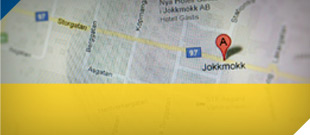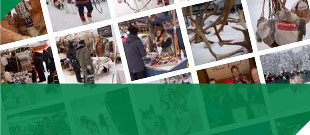Lule Lappish Territory
The land in the north was divided into five areas already from the days of king Gustav Vasa: Ume, Pite. Lule, Torne and Kemi Lappish territories. In the Lule Lappish territory the inhabitants belonged to four villages, namely Sjocksjock, Jockmock, Sirkas and Tuorpon. The Sámi lived mainly by hunting and fishing and moved between different fishing lakes. Reindeer were used as draft animals and as a lure for hunting the wild reindeer.
The population in Lule was small. According to tax records from the first decades of the 17th century, it consisted of 150-200 households. The tax collectors, and the merchants from the coastlands of Norrbotten traded with the Sámi and had, until the middle of the 16th century, the right to collect taxes. For this privilege they paid a lease to the crown. The tax collectors contacted the Sámi where they were settled during the winter, but there were also marketplaces for the Lule Lappish territories farther down the river valley, in areas around Harads and Bredåker. Probably their market was held in mid-winter as well.
Tax and trading articles which left the area were skins and leather goods made from animals which were hunted as well as reindeer and dry fish. The crown was interested in live reindeer. Both the reindeer and reindeer herders, preferably women, were taken south for a period of time. Articles which were imported were things like salt, butter, flour, silver, homespun, broadcloth and iron goods.
When permanent market and church locations were to be established, they looked for areas which could be reached in the wintertime and which were near areas in which the Sámi grazed their reindeer. The village of Jockmock had had winter grazing for a long time in the forest area by the little and the big Lule rivers. The ridge which runs east to west above a marshy area (present day Talvatis Lake), was chosen as the location of the first church in Jokkmokk. The Sámi name was Dálvvadis, which means winter settlement. A simple parsonage, a tax collector booth and market booths were built. But it took a long time before a parish priest lived permanently in the church town of Jokkmokk. Instead the priests would travel up from the coast for the markets and preach their sermons, hold catechetical meetings, weddings and baptisms as well as update the parish register.
The obligation to go to church was the law of the land, and this included the Sámi. However it was possible only during the market time, when there was already a lot to do. One of the priests in the 17th century complained that things were terribly busy during the market time. There was so much to do that people did not have the time to go to church, even if the services would be held at night.
Traditional Sámi religious rites and ceremonies continued alongside the church's established rituals, and were probably the strongest of the two. Children who were to be baptized by the priest had already been given their Sámi name in a christening ceremony shortly after birth. The parents chose a name for the child from a deceased relative whose positive character they wanted to see in their child. After the church baptism they carried out a cleansing ceremony to wash away the Christian name which could actually be harmful to the child. Church weddings were not considered important. The marriage proposal was that which was important and that both families were in agreement. But little by little as church population records were established in the Lappish territories, the Christian ceremonies gained in importance. According to Sámi beliefs, the dead lived on in a shadow world. So funerals were not that important. Often the dead corpse was left in the mountains in a crevice covered with rocks to protect it from wild animals. Burials could only take place when the ground was not frozen. The bodies were transported to the church and put in a burial booth beside the church until the ground thawed out and the funeral could take place.
In the 18th century the church's mission to the Sámi became harsher. Under the influence of Pietism a personal conversion was demanded as well as a clear denial of the old faith. The church and the state confiscated Sámi drums and persecuted the shamans and others who tried to maintain their traditional convictions.












